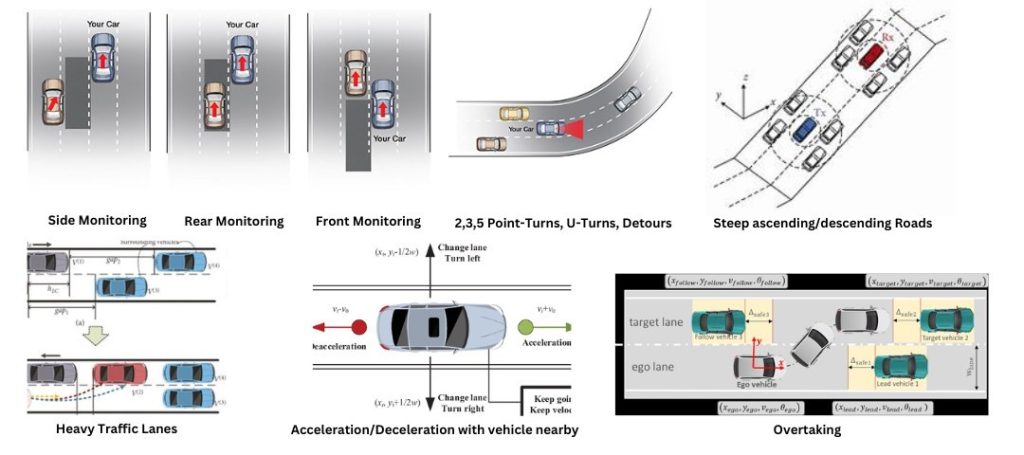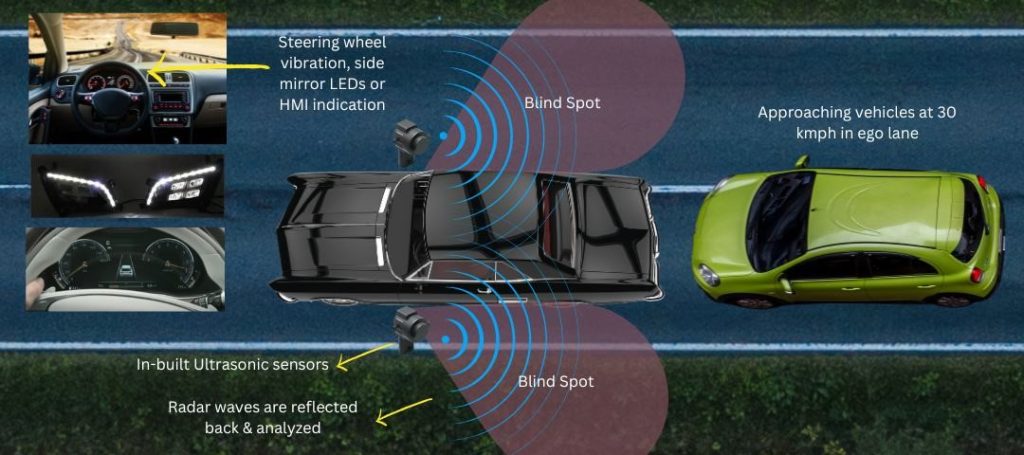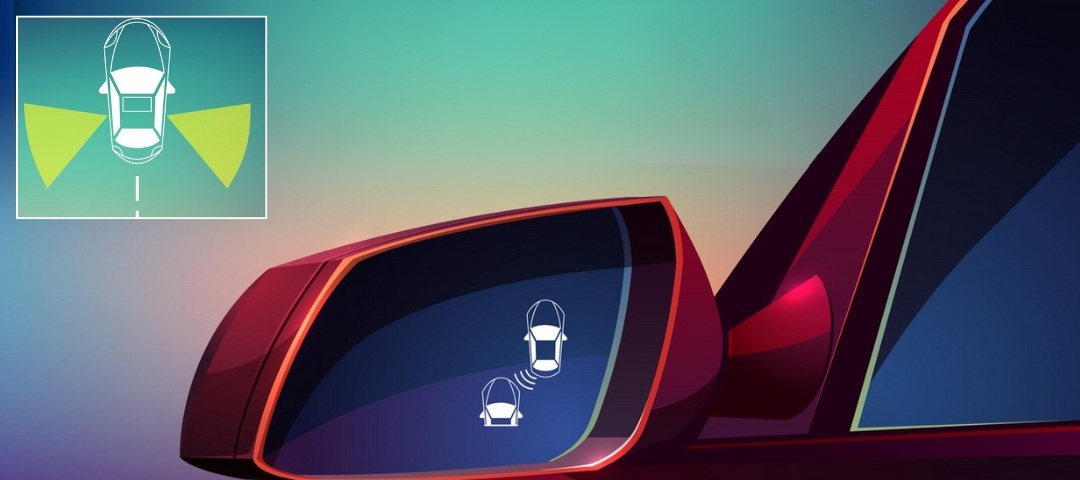What are Blind Spot Monitoring Systems?
Blind spot monitoring systems are additional safety features that provide audio and visual alerts to the driver regarding blind spots during unsafe lane change attempts and potential cases for accidents. These alerts are empowered by radar-based systems that work in coordination with blind spot monitors to detect and assist with driving in rear and cross-traffic. These systems are in built as a convenient feature in modern cars which allows keeping an eye on spots during lane changes that a mirror reflection may amiss. A report suggests that around 800,000 accidents with more than 300 fatalities are caused by blind spots alone, in the US.
Car blind spot detection systems are also called No Zones detection, for example, when being followed by a large truck, or driving behind one, one cannot observe the area using only rearview mirrors, and thus, intersections, high-speed highways, roundabouts, changing or merging lanes, overtaking etc. can prove to be dangerous and result in rear-ender or broadside collisions. Blind spots can also occur when any vehicle is traversing alongside the driver’s vehicle which cannot be observed using mirrors as they monitor the vehicle approaching from behind. Another cause of blind spot-based accidents are side mirrors which are convex in nature, and the vehicles approaching from behind may appear to be closer than in real, whereas chassis columns surrounding the vehicle’s windows and doors can also be a cause. Blind spots may also vary depending upon the driver’s height and vehicle model. Blind spot detection systems usually stay in the background during normal driving conditions without the need for any intervention and can be turned off if not required. As of 2021, the global blind spot monitoring system market was sized at $1.73 billion and is projected to reach a value of approximately $3.11 billion by 2027, surging at an increase of 8.8% year-on-year.

Rising global blind spot monitoring system market size from 2019 to 2027
Working of Blind Spot Detection System
Blind spot monitoring systems detect vehicles by using a quasi-millimeter wave radar present outside the vehicle, that has a sensing range extending up to 60 meters towards the rear in the adjacent lane. When the driver seeks to change lanes, an area of the brim of the outer rearview mirrors or the inside of the front door near the mirrors or on the bumpers, starts to illuminate to indicate an obstacle, which may not be visible in the driver’s eye-line. Let us take a deeper understanding of how this phenomenon works.
System Integration
Blind spot detection systems integrate with other ADAS solutions preexisting in the diver’s vehicle, such as lane departure warning or collision avoidance systems and provide a complete comprehensive safety package. The output or settings can be accessed through Human-Machine Interface present in the dashboard of the vehicle. Algorithms present in ADAS, or blind spot detection system can alert drivers through estimated calculations by considering factors such as vehicle’s speed, steering angle etc. and in turn change signal status to avoid any sort of unnecessary distractions.
Zone Monitoring
Radar wave sensors are positioned in a strategic manner around the vehicle, usually in the aforementioned areas. Car blind spot detection systems continuously monitor the adjacent lanes for other vehicles or obstacles. Each sensor covers a specific area known as a blind spot, for example in the case of Audi Side Assist systems. These zones typically extend from the side mirrors to several feet behind the vehicle. Some systems may also cover areas slightly ahead of the vehicle, depending on the design. These systems work with radars, ultrasonic sensors and cameras, known as the sensor fusion. Algorithms controlling these components combine sensor data to improve detection accuracy over time to reduce false positives. Initial radio waves emitted by radar sensors analyze reflected signals for the next steps like object detection. Then, signal processing algorithms analyze the received data and determine distance range, relative speed, approaching object size etc., where relative velocities are commonly measured using Doppler processing

Use cases of blind spot detection system
Object Detection
When a vehicle or object enters the monitored blind spot zone, the sensors detect its presence. This detection can be based on extracted features from sensor data that indicate various factors, such as the size, speed, motion characteristics, and distance of the object like pedestrian, approaching vehicle etc. relative to the host vehicle’s universal blind spot monitoring system. Surround view cameras placed in appropriate positions over the vehicle capture images of the surrounding environment. These images are analyzed by the system by using image processing algorithms like edge detection, object segmentation, pattern recognition that ultimately helps to identify vehicles and obstacles in the blind spot. Different types of neural networks and other types of unsupervised learning algorithms are trained to recognize patterns in the sensor data and recognize accidentals hazards. With active learning procedure their detection accuracy improvises over time in real-life scenarios. In case sensors generate noisy measurement data, Kalman filters are commonly used to tackle such situations by predicting future position and object velocities. These predictions are combined with incoming sensor data to improvise the accuracy of tracking by these systems.
Alert Generation
Car blind spot detection system algorithms assess collision risk based on relative speed and distance between detected object and the vehicle and provide warning to the driver when an accident is eminent. When the system detects vehicles a blind spot warning in car is generated to alert the driver, which can be in a visual indicator form, for example, LEDs on the rearview and dashboard or an audible alert such as chimes or beeps like in MG models. Many modern vehicles also use haptic feedback, for example, steering wheel vibration, steering impulses or seat vibration to alert the driver, such that the driver stays focused on the road and is not alarmed by potential accident scenario. This helps the driver take appropriate action, such as refraining from lane changing in time.
Benefits of Blind Spot Detection System
As per a report by the Insurance Institute for Highway Safety, a non-profit organization that provides vehicle safety reviews across the US, around 23% of accidents during lane change have been reduced due to integration of car blind spot detection system. Given below are a few more advantages of these systems:
- Awareness: Universal blind spot monitoring systems widen a driver’s awareness about their surroundings. They utilize sensors to monitor rear corners, and other areas which are typically difficult to observe while focusing on driving. Being a part of Advanced Driver Assistance System (ADAS), these systems assist drivers to become aware of nearby obstacles and vehicles, such as Motorcycles (MC 50CC, MC EX50CC, MCWOG/FVG, M/CYCL WG), Medium Goods Vehicle (MGV) Light Motor Vehicle (LMV-NT, LMV), Heavy Motor Vehicles (HMV, HGMV, HPMV, HTV), Trailers etc., which may not be visible through the mirrors alone.
- Adaptable: Blind spot detection system can work and assist drivers in varied scenarios such as adverse weather conditions, different types of lighting conditions, day or night etc. These systems can be customized and seamlessly integrate in existing features of the vehicle’s ADAS solution, HMI etc. They make lane changes smooth by giving drivers an accurate impression of nearby vehicle’s positioning, speed, movement and enhancing their driving perception, for example, lane change and blind spot warning in cars like Lexus NX, BMW X1 etc.
- Safety: The primary purpose of blind spot monitoring systems is enhancing road safety by reducing collision risks, especially on highways, occupied streets etc. where traffic changes quite rapidly and AI pattern recognition plays an eminent role. They reduce blind spot accidents by alerting drivers of sudden lane changes, adjacent lane obstacles, and merging maneuvers, visually, such as LEDs around rearview mirrors and through audible warnings.

Working of blind spot warning in car
- Convenience: Drivers get the assurance and extra layer of security of safety monitoring by car blind spot detection systems. Knowing the vehicle’s surroundings boosts the driver’s confidence in heavy traffic and challenging situations that require driving expertise. They do not need to turn heads multiple times to observe the mirror while focusing on other important things since LEDs automatically turn on and off in cases when other vehicles are trying to overtake or are present in adjacent lane. As mentioned earlier, they seamlessly integrate with existing ADAS solutions to render effective rear cross-traffic alerts, lane departure warnings etc. that altogether offer a comprehensive safety package.
- Others: Blind spot detection system prevents accidents, safeguards drivers against injuries and minimizes repair costs related to mechanical components of vehicles. Some insurance companies even offer discounts to damaged vehicles which are equipped with ADAS features such as blind spot monitoring systems etc.
Change Lanes with Confidence
KritiKal Solutions can develop efficient blind spot monitoring systems to increase your agility on the road and make you prepared for the next maneuver. Our robust lane change warning systems assist to safely execute the same by supporting the side mirror and over the shoulder viewing of notorious blind spots. It alerts you to the presence of pedestrians, animals, other vehicles approaching or dangerously close, which might otherwise be overlooked by evaluating potential hazards in the blind spot or nearby, ensuring a safe lane change. This heightened visibility enhances your driving experience, instilling added assurance and tranquility during motorway journeys, as you change lanes precisely and remain fully aware of your surroundings. We also offer complete ADAS solutions featuring naturalistic driver behavior, vehicle taillight recognition, driver drowsiness detection, road signs and traffic signal detection and much more. Please mail us at sales@kritikalsolutions.com to know more and avail our services.

Sonu Kumar currently works as an Associate Architect at KritiKal Solutions. With more than 8 years of experience, he is a software developer with a passion for exploring, learning and developing new technologies. He is proficiently skilled in OpenStack, NFV automation and deployment, Data Structures and Algorithm, System Design, Object Oriented Design, Python, Java, MySQL etc. He has helped KritiKal in delivering various projects to some major clients.

 Global
Global  United States
United States 